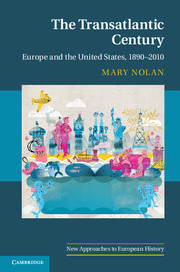Book contents
- Frontmatter
- Contents
- Illustrations
- Maps
- Tables
- Acknowledgments
- Introduction
- 1 An uncertain balance, 1890–1914
- 2 World War I: European crisis and American opportunity
- 3 Ambivalent engagement
- 4 The depression and transatlantic new deals
- 5 Strange affinities, new enemies
- 6 From world war to Cold War
- 7 Cooperation, competition, containment
- 8 Culture wars
- 9 The American Century erodes, 1968–1979
- 10 Renewed conflict and surprising collapse
- 11 A widening Atlantic
- 12 Imperial America, estranged Europe
- Suggested readings
- Index
- References
10 - Renewed conflict and surprising collapse
Published online by Cambridge University Press: 05 November 2012
- Frontmatter
- Contents
- Illustrations
- Maps
- Tables
- Acknowledgments
- Introduction
- 1 An uncertain balance, 1890–1914
- 2 World War I: European crisis and American opportunity
- 3 Ambivalent engagement
- 4 The depression and transatlantic new deals
- 5 Strange affinities, new enemies
- 6 From world war to Cold War
- 7 Cooperation, competition, containment
- 8 Culture wars
- 9 The American Century erodes, 1968–1979
- 10 Renewed conflict and surprising collapse
- 11 A widening Atlantic
- 12 Imperial America, estranged Europe
- Suggested readings
- Index
- References
Summary
At the beginning of 1989, political calm, as cold and gray as the weather, hung over Eastern Europe; by early summer striking political changes were underway. In June a coalition led by the independent trade union Solidarity swept the Polish elections, and roundtable negotiations established the non-communist Polish Republic with Lech Wałesa at its head. Next came Hungary, where the long-demanded reburial of Imry Nagy, prime minister during the 1956 uprising, brought thousands into the streets, and negotiations established a multiparty government. On November 9 East Germany opened the Berlin Wall, thousands of East and West Germans sang, danced, and celebrated on top of that hated symbol, and the Socialist Unity Party quickly stepped down. In November and December Czechoslovakia’s Velvet Revolution brought the noted dissident and literary figure Václav Havel to power. As the year ended Ceauşescu’s notoriously repressive regime in Romania was overthrown by force, and with much less fanfare, the Bulgarian leader Todor Zhivkov resigned, and the country began a halting transition to parliamentary democracy.
With the exception of Romania, regimes collapsed and Communist parties retreated rather than violently resisting protest movements, the demands of prominent dissidents, or the examples of neighboring states. Of more importance, the Soviet Union did not oppose these revolutions or block the reunification of Germany. Nor did it survive them, for in 1991 communism collapsed and the multinational Soviet Union dissolved. The ideological struggles, political geography, and economic and cultural competition that had structured European-American relations in the second half of the twentieth century vanished – to the surprise of direct participants and observers alike.
- Type
- Chapter
- Information
- The Transatlantic CenturyEurope and America, 1890–2010, pp. 304 - 330Publisher: Cambridge University PressPrint publication year: 2012



